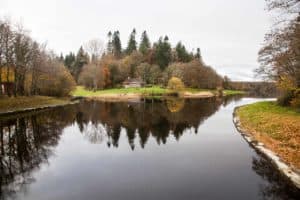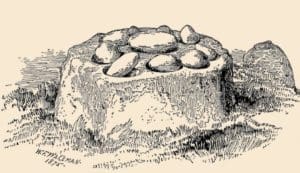The Amazon Rainforest: The Lungs of Our Planet and Its Peoples – Unveiling Their Vital Role

Updated On: March 13, 2024 by Noha Basiouny
The Amazon Rainforest, often termed the ‘Lungs of the Planet’, is a vital organ in the Earth’s environmental system. Remarkably biodiverse and expansive, it spans across nine countries in South America, displaying a stunning array of flora and fauna unmatched anywhere else in the world. This rainforest doesn’t just contribute to local ecology but plays a crucial role in regulating the global climate. Its dense foliage acts as a significant carbon sink, absorbing large amounts of carbon dioxide from the atmosphere, and in return, provides the oxygen that supports life.
Traditionally, indigenous peoples have called the Amazon their home, living in harmony with its intricate ecosystem. Their knowledge of the rainforest’s plants and animals is indispensable for scientific understanding and conservation efforts. However, this incredible biome is under threat from deforestation and climate change. The loss of the Amazon’s rich forest cover to agricultural expansion, logging, and fires brings with it a host of consequences, threatening its ability to function as a carbon sink and climate stabiliser. Acknowledging these threats is essential to not only the survival of the forest itself but to us as a global community.
The Amazon Rainforest Ecosystem
The Amazon Rainforest is not only a vast repository of biodiversity but also an integral component of the Earth’s ecological balance. Within this ecosystem, interdependent relationships between flora and fauna play a critical role in sustaining the environment.
Flora and Fauna Diversity
The Amazon teems with unrivalled biodiversity. It is estimated to house over 390 billion individual trees, divided into 16,000 species. Among these, the rubber tree (Hevea brasiliensis) and the giant water lily (Victoria amazonica) stand out for their ecological roles and cultural significance. Noteworthy is the remarkable adaptation of many plant species to fluctuating water levels in the region.
Our attention to fauna reveals a staggering array of species; approximately 2.5 million insect varieties, tens of thousands of plants, and some 2,000 birds and mammals inhabit this area. To spotlight a few, the jaguar (Panthera onca), the green anaconda (Eunectes murinus), and the Amazon river dolphin (Inia geoffrensis) are iconic symbols of the Amazon’s wildlife diversity.
Significance of Biodiversity

The biodiversity of the Amazon is not just an encapsulation of life’s variety but a cornerstone of the global ecosystem. The rainforest supports countless species, including our own, by contributing to global oxygen production and carbon sequestration. Studies suggest that the Amazon’s carbon sink—its ability to absorb more carbon dioxide than it emits—is crucial in mitigating climate change, although it’s under threat from deforestation and climate-induced stressors.
Moreover, the symbiotic relationships between the Amazon’s species create a robust ecosystem where each organism contributes to the health of the whole. For instance, fruit-eating animals such as toucans disperse seeds, aiding in plant distribution and genetic diversity, which in turn supports a stable and resilient environment.
In summary, our exploration of the Amazon Rainforest Ecosystem lays bare the intricate weave of life that exists within this precious biome. It underscores our responsibility to safeguard such natural wonders for the ongoing health of our planet.
Climate Regulation and Global Impact
We are facing a critical moment where the effective functioning of the Amazon rainforest is paramount to the health of our planet. Its role in managing the balance of greenhouse gases and influencing weather patterns cannot be overstated.
Carbon Cycle and Atmospheric Balance
The Amazon is a key enabler in the global carbon cycle, acting as a vast sink for atmospheric carbon dioxide. It’s estimated that the rainforest can absorb billions of tonnes of carbon dioxide each year, significantly mitigating the impact of climate change. However, deforestation and climate-induced stresses are threatening this capacity, risking the release of immense amounts of carbon back into the atmosphere, a stark reminder detailed in a recent report.
Influence on Global Weather Patterns
Our climate is intricately linked to the health of the Amazon. This rainforest contributes to the regulation of global weather patterns by releasing water vapour and heat energy into the atmosphere. This process affects rainfall distribution far beyond its borders, impacting agriculture and water supply on a continental scale. However, with the rainforest at risk as highlighted by studies like those mentioned by BBC News, the potential for alteration in weather patterns presents yet another concern for global stability.
Deforestation Threats and Consequences

Deforestation in the Amazon threatens the stability of global climate, the richness of biodiversity, and the livelihoods of indigenous peoples. The consequences are tallied not only in lost habitats and species but also in the increased emissions that propel climate change.
Agriculture and Cattle Ranching
The drive for agricultural expansion, notably soy farming and cattle ranching, is a principal agent of deforestation. To clear land for these ventures, vast swathes of forest are often slashed and burnt, leading to a cascade of environmental degradation. These actions not only strip away the trees that absorb carbon dioxide but also release the carbon stored in them, exacerbating greenhouse gas emissions.
- Main Contributors:
- Soy Farming: An expanding global market for soy as livestock feed compels further deforestation.
- Cattle Ranching: Beef trade demands prompt forest clearance to make way for grazing lands.
Illegal Logging and Mining
Illegal activities, particularly logging and mining, pose severe threats to the Amazon Rainforest. Unauthorised loggers fell valuable trees, while illegal miners disrupt ecosystems by polluting rivers with toxic substances. Such incursions not only cause irrevocable harm to flora and fauna but also generate conflicts with indigenous communities whose lives and cultures are interwoven with these landscapes.
- Detrimental Impacts:
- Biodiversity Loss: Selective removal of specific tree species can collapse the intricate web of forest life.
- Disruption of Local Communities: Illegal operations often result in the displacement of indigenous peoples and degradation of their ancestral lands.
Conservation Efforts and Challenges
In addressing the urgent need to safeguard the Amazon Rainforest, we recognise both the innovative measures being taken and the formidable hurdles that remain. With global warming on the rise, it’s imperative that law enforcement and restoration initiatives work hand in hand to ensure the longevity of this vital ecosystem.
Law Enforcement and Policy
One of the significant strides in conservation efforts involves stringent law enforcement and the implementation of robust policies. Countries within the Amazon Basin have imposed fines and other legal repercussions for illegal deforestation activities. However, the challenge lies in effectively patrolling this vast territory. We see an urgent need for stronger international collaboration to bolster regional law enforcement capabilities. Such a cooperative approach would not only lead to more consistent application of the law but also underscore the global commitment to combating climate change.
Restoration Projects
Restoration projects in the Amazon are crucial in combating global warming and repairing the damage done by deforestation. We witness numerous initiatives where thousands of hectares are being reforested with native species. This not only helps to absorb carbon dioxide from the atmosphere but also restores habitats for the rich biodiversity found in the region. Despite the progress, the scale of these projects is often limited by funding and logistic complexities. Scaling up such initiatives is our chief concern, requiring both national commitment and international support.
Indigenous Peoples and Traditional Knowledge
In the heart of the Amazon, Indigenous peoples are the custodians of a wisdom critical to conserving the rainforest ecosystem and addressing climate change.
Role in Conservation
Ecosystem Management: We observe how the Indigenous peoples’ profound understanding of the Amazon’s biodiversity turns them into invaluable allies in ecosystem management. Through practices honed over generations, these communities maintain the health of the rainforest which is essential to combating climate change. The stewardship of Indigenous peoples has shown to result in lower deforestation rates, evidenced by a United Nations report which highlights that indigenous lands show lower deforestation compared to other areas.
Climate Change Mitigation: Indigenous practices contribute significantly to climate change mitigation. Their traditional knowledge supports biodiversity and helps store carbon, which is key to lessening the impact of global warming. A recent collaboration with Thomson Reuters Foundation reveals how Indigenous culture has protected the Amazon by promoting sustainable land usage that aligns with the natural cycles of the environment.
Cultural Significance
Continuing Traditions: The wisdom of the Amazon’s Indigenous peoples is not just a tool for conservation—it is a cornerstone of their cultural identity. Practices developed over centuries are passed down, showing a respect for the forest that sustains their way of life. Portrayed by Oxfam International, Indigenous rangers like those in Quitununquiña, Bolivia, work tirelessly to preserve these traditions against the encroachment of fires and deforestation.
Sustaining Biodiversity: Each Indigenous community has a unique relationship with specific elements of the Amazon, which in turn shapes the ecological balance of the rainforest. From traditional farming techniques to the spiritual significance of various plant and animal species, these relationships foster an intrinsic respect for maintaining biodiversity. This synergy has been acknowledged globally, including at forums like COP27 where the importance of Indigenous knowledge was emphasised for safeguarding our environment.
Through these lenses, the role of Indigenous peoples goes beyond mere inhabitants of the rainforest. They are active participants in the fight against climate change, utilizing traditional knowledge to sustain the ecosystems they call home. Their deep connection to the land offers lessons in resilience and environmental stewardship that must be integrated with global conservation efforts.
Scientific Research and Understanding
In order to grasp the complexity of the Amazon Rainforest and its global significance, we focus on the diligent studies conducted by teams of researchers and scientists. Their work enhances our understanding of the rainforest’s intricate ecosystem and informs predictions about its future.
Studying the Rainforest’s Responses
Scientists, such as Carlos Nobre, among others, have shown an unwavering commitment to examining the Amazon’s environment. Their research has revealed that the rainforest is not the main producer of 20% of Earth’s oxygen, as was widely believed. In fact, meticulous studies have corrected this misunderstanding. With the use of satellite imagery and data analysis, the rainforest’s true contribution to oxygen production and carbon absorption is examined. This understanding is crucial, as it shapes our conservation efforts and policies. Recent findings underscore the rainforest’s role in absorbing a significant portion of carbon dioxide, which is pivotal in mitigating climate change.
Predicting Future Patterns
Predictive models are an integral part of research, providing insights into the Amazon’s future dynamics. Specialists in climatology and ecology work on simulations to predict changes in biodiversity, climate impact, and the possibility of reaching a tipping point. Their studies suggest that deforestation and climate change might lead to the Amazon converting from a dense forest to a savannah-like ecosystem. By charting the rainforest’s capacity to sequester carbon, researchers assess its health and ability to continue serving as a vital carbon sink. These forecasts are essential for creating strategies aimed at preserving the rainforest and preventing detrimental outcomes.
Our collective knowledge and understanding continually evolve with ongoing research, highlighting the importance of the Amazon, not only for the local populations but for the entire world.
The Carbon Sink and Its Limitations
Understanding the role of the Amazon Rainforest as a carbon sink is essential to gauge its impact on our planet’s health. Yet, there are emerging signs that this pivotal ecosystem could face limitations in its capacity to absorb carbon dioxide.
Photosynthesis and Carbon Storage
The Amazon Rainforest is an immense carbon sink, primarily due to the process of photosynthesis, where plants absorb carbon dioxide and sunlight to produce oxygen and glucose. This biological process is the foundation of the rainforest’s ability to store carbon. The dense vegetation and biodiversity of the Amazon are instrumental in this task, with an estimated 2.6 million square miles of forest acting collectively to sequester large quantities of carbon.
Potential to Become a Carbon Source
However, recent observations and studies have brought up concerns that the Amazon might transition from a carbon sink to a carbon source. Deforestation, climate change and forest fires are contributing to a decrease in the Amazon’s ability to absorb carbon. Regions that were once dense with vegetation are thinning; changes that not only alter the forest structure but also reduce carbon uptake. Furthermore, with a weakened carbon sink, the Amazon could exacerbate global warming by releasing stored carbon back into the atmosphere.
Threat of Tipping Points and Ecosystem Collapse
In the Amazon Rainforest, the convergence of climate extremes and deforestation is pushing the ecosystem to its limits. Our attention is drawn to the very real possibility of reaching tipping points that could lead to an irreversible collapse.
Effects of Climate Extremes
With rising global temperatures, we are witnessing more frequent climate extremes that profoundly impact the Amazon. The dry season is intensifying, leading to conditions that increase the likelihood of fires and tree mortality. When temperatures soar beyond the norm, the resilience of the forest is compromised, exacerbating the risk of a transition to a savanna-like environment.
Irreversible Damage Scenarios
As we consider the potential for irreversible damage, scenarios unfold where large parts of the Amazon could deteriorate drastically. Such a collapse could see up to 47% of the rainforest transformed into degraded ecosystems by 2050. In these scenarios, the loss of biodiversity and the disruption to the global carbon cycle would be catastrophic. The Amazon, often referred to as our planet’s lungs, is on the verge of hitting critical ecological tipping points due to the combined pressures of climate change and human interventions.
Role in the Global Oxygen Supply

The Amazon Rainforest is instrumental in the global oxygen cycle, playing a critical role that extends far beyond its geographical boundaries.
Oxygen Production and Regulation
The Amazon serves as a vital component of our planet’s respiratory system. It is responsible for the production of a significant portion of the Earth’s oxygen through the process of photosynthesis. Trees and plants absorb carbon dioxide and release oxygen during this natural cycle, contributing to the regulation of atmospheric gases. While the exact percentage varies, estimates suggest that the Amazon contributes to around 6% of the planet’s oxygen currently available in the atmosphere, meaning it helps sustain the oxygen that all aerobic organisms require to live.
Misconceptions about Oxygen Contribution
Despite popular belief, the Amazon is not the “lungs of the planet” in the sense that it does not produce 20% of the Earth’s oxygen. Scientific studies have clarified this misconception by explaining that the majority of the Earth’s atmospheric oxygen comes from the oceans, particularly from phytoplankton. Furthermore, most of the oxygen produced by the Amazon is used by the forest’s own ecosystem and thus, the net contribution to the global oxygen supply is significantly less. Understanding this is essential in accurately appreciating the Amazon’s influence on the global oxygen supply.
The intricate balance maintained by the Amazon is a testament to its importance, not just as a source of oxygen, but as a key element in the intricate web of life that sustains us all.
Impact of Human Activities
The Amazon, often termed as the planet’s lungs, is increasingly compromised due to human activities. Through deforestation and degradation, we’re influencing the balance of this vital biome.
Expansion of Agriculture and Infrastructure
Agriculture has been a primary driver behind the deforestation of the Amazon Rainforest. The demand for crops and cattle ranching occupies sizable tracts of land that were once dense forests. This expansion not only diminishes biodiversity but also releases carbon dioxide stored in trees. As reported by the World Economic Forum, the majority of the Amazon region is struggling to recover from such disturbances, especially in areas proximal to human settlements or those with lower rainfall.
Infrastructure developments, encompassing roads and urban expansion, further fragment these once unbroken forests. This fragmentation threatens indigenous communities, wildlife, and the entire ecosystem’s resilience.
Sustainable Practices and Alternatives
It’s not too late for us to adopt sustainable practices, turning to alternatives that do not strain the rainforest. Implementing agroforestry and supporting indigenous farming methods can provide livelihoods without the extensive clearing of forests. Ensuring any developments respect the fragile balance of the rainforest is crucial.
Moreover, a NASA study emphasises the impact of human-induced dryness in the Amazon. By maintaining the forest’s integrity, we inherently support its ability to manage local and global water cycles, emphasising sustainable approaches to forest management.
The approach to the forest needs a paradigm shift. As the study published in Nature indicates, the threat to the Amazon’s future is clear, yet we have the knowledge to forge a different path, one that balances human needs with the necessity of preserving this global treasure.
Climate Change Indicators and the Amazon’s Future
The Amazon Rainforest is profoundly affected by climate change indicators such as global warming and water stress which threaten its future. Predictive models help us anticipate changes while adaptation strategies aim to bolster the rainforest’s resilience.
Monitoring and Predictive Models
Monitoring the Amazon is crucial for understanding how climate change impacts this vital ecosystem. We utilise advanced satellite imagery to discern patterns of deforestation and observe shifts in vegetation health. Predictive models then extrapolate these observations to forecast future scenarios. These models have flagged a possible tipping point for the Amazon by 2050, projecting increased instances of extreme droughts that could severely compromise the rainforest’s integrity and diversity.
Adaptation and Resilience Strategies
Adaptation strategies are imperative for the survival of the Amazon. We recognise the need for local and global actions to mitigate water stress and combat the adverse effects of global warming. Indigenous knowledge is at the forefront of stewardship practices that promote ecosystem resilience. Meanwhile, initiatives focusing on reforestation and sustainable land management are gathering momentum, aiming to strengthen the Amazon’s natural capacity to recover from environmental disturbances.
Frequently Asked Questions
In this section, we address several key questions that often arise regarding the Amazon rainforest’s essential roles in our planet’s health and the well-being of its peoples.
Why is the Amazon rainforest often described as the world’s respiratory system?
The Amazon rainforest is frequently likened to the world’s respiratory system because it produces a significant amount of the Earth’s oxygen through photosynthesis. While it does not produce 20% of the planet’s oxygen, as often mistakenly claimed, the Amazon does play a critical role in recycling carbon dioxide into oxygen.
What are the ecological functions of the Amazon rainforest that contribute to its ‘lungs of the planet’ reputation?
The ecological functions of the Amazon rainforest include carbon sequestration, where trees absorb carbon dioxide from the atmosphere, and the release of oxygen. Moreover, it regulates temperature and rainfall patterns both locally and globally, which is vital for sustaining the Earth’s overall climate.
How does the Amazon rainforest impact global carbon dioxide levels?
The Amazon rainforest has a profound impact on global carbon dioxide levels by acting as a carbon sink. It absorbs large quantities of carbon dioxide through the process of photosynthesis. This storage capability helps mitigate the greenhouse effect, which is crucial in the fight against climate change.
What role does the Amazon rainforest play in supporting indigenous communities?
The Amazon rainforest supports numerous indigenous communities by providing essentials such as food, shelter, and medicine derived from its vast biodiversity. These communities also maintain a deep cultural connection to the forest, which is integral to their heritage and way of life.
What are the consequences of deforestation in the Amazon rainforest for the global climate?
Deforestation in the Amazon rainforest leads to a reduction in the region’s capacity to absorb carbon dioxide, exacerbating global warming. It also disrupts the hydrological cycle that influences global weather patterns, potentially leading to more extreme climate events.
In what ways are conservation efforts in the Amazon rainforest being implemented and what challenges do they face?
Conservation efforts in the Amazon include establishing protected areas, enforcing anti-deforestation laws, and promoting sustainable land use practices. However, these efforts face challenges such as illegal logging, mining, and agricultural expansion, often driven by economic pressures.






